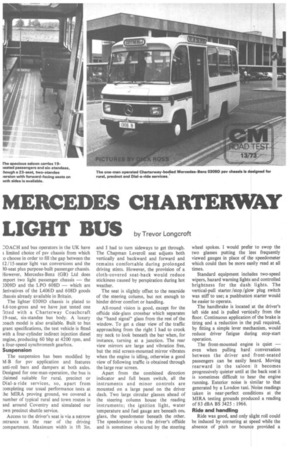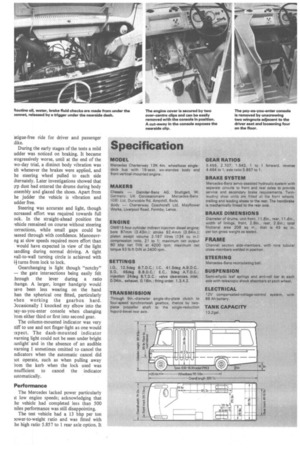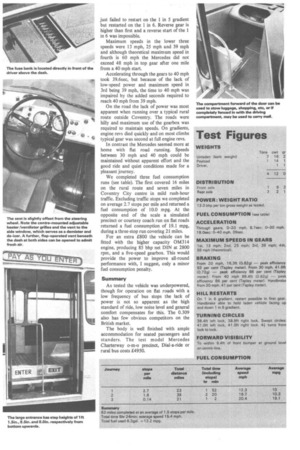MERCEDES CHARTERWAY
Page 58

Page 59

Page 60

If you've noticed an error in this article please click here to report it so we can fix it.
LIGHT BUS by Trevor Longcroft
20ACH and bus operators in the UK have I limited choice of psv chassis from which o choose in order to fill the gap between the 12 /15-seater light van conversions and the 30-seat plus purpose-built passenger chassis. However, Mercedes-Benz (GB) Ltd does mport two light passenger chassis — the )309D and the LPO 608D — which are ierivatives of the L406D and 608D goods ;hassis already available in Britain.
The lighter 0309D chassis is plated to 4.6-ton-gross and we have just tested one itted with a Charterway Coachcraft 19-seat, six-standee bus body. A luxury :oach model is also available. Built to bus ;rant specifications, the test vehicle is fitted with a four-cylinder indirect injection diesel mgine, producing 60 bhp at 4200 rpm, and a four-speed synchromesh gearbox.
Suspension The suspension has been modified by !vI-B for psv application and features anti-roll bars and dampers at both axles. Designed for one-man-operation, the bus is :laimed suitable for rural, precinct or Dial-a-ride services, so, apart from :ompleting our usual performance tests at :he MIRA proving ground, we covered a number of typical rural and town routes in and around Coventry and simulated our Dwn precinct shuttle service.
Access to the driver's seat is via a narrow ntrance to the rear of the driving :ompartment. Maximum width is lft 3in. and I had to turn sideways to get through. The Chapman Leveroll seat adjusts both vertically and backward and forward and remains comfortable during prolonged driving stints. However, the provision of a cloth-covered seat-back would reduce stickiness caused by perspiration during hot weather.
The seat is slightly offset to the nearside of the steering column, but not enough to hinder driver comfort or handling.
All-round vision is good, except for the offside side-glass crossbar which separates the "hand signal" glass from the rest of the window. To get a clear view of the traffic approaching from the right I had to crook my neck to look beneath the bar when, for instance, turning at a junction. The rear view mirrors are large and vibration free, but the mid screen-mounted mirror vibrates when the engine is idling, otherwise a good view of following traffic is obtained through the large rear screen.
Apart from the combined direction indicator and full beam switch, all the instruments and minor controls are mounted on a large panel on the driver dash. Two large circular glasses ahead of the steering column house the reading instruments; the ignition light, water temperature and fuel gauge are beneath ont. glass, the speedometer beneath the other. The speedometer is to the driver's offside and is sometimes obscured by the steering wheel spokes. I would prefer to swop the two glasses putting the less frequently viewed gauges in place of the speedometer which could then be more easily read at all times.
Standard equipment includes two-speed wipers, hazard warning lights and controlled brightness for the dash lights. The vertical-pull starter /stop /glow plug switch was stiff to use; a pushbutton starter would be easier to operate.
The handbrake is located at the driver's left side and is pulled vertically from the floor. Continuous application of the brake is tiring and a reduction in the pull required, by fitting a simple lever mechanism, would reduce driver fatigue during stop-start operation.
The front-mounted engine is quiet — even when pulling hard conversation between the driver and front-seated passengers can be easily heard. Moving rearward in the saloon it becomes progressively quieter until at the back seat it is sometimes difficult to hear the engine running. Exterior noise is similar to that generated by a London taxi. Noise readings taken in near-perfect conditions at the MIRA testing grounds produced a reading of 83 dBA BS 3425 1966.
Ride and handling Ride was good, and only slight roll could be induced by cornering at speed while the absence of pitch or bounce provided a 'atigue-free ride for driver and passenger dike.
During the early stages of the tests a mild udder was noticed on braking. It became trogressively worse, until at the end of the wo-day trial, a distinct body vibration was elt whenever the brakes were applied, and he steering wheel pulled to each side dternately. Later investigations showed that ;rp dust had entered the drums during body tssembly and glazed the shoes. Apart from he judder the vehicle is vibration and udder free.
Steering was accurate and light, though ncreased effort was required towards full ock. In the straight-ahead position the Thiele remained on course without steering :orrections, while small gaps could be iassed through with confidence. Manoeuvrng at slow speeds required more effort than would have expected in view of the light landling during normal driving. A tight vall-to-wall turning circle is achieved with 1.1 turns from lock to lock.
Gearchanging is light though "notchy" — the gate intersections being easily felt ;hrough the lever during a ratio :hange. A larger, longer handgrip would lave been less wearing on the hand han the spherical one fitted, particularly when working the gearbox hard. Dccasionally I knocked my elbow into the my-as-you-enter console when changing 'rom either third or first into second gear.
The column-mounted indicator was very ;tiff to use and not finger-light as one would :xpect. The dash-mounted indicator yarning light could not be seen under bright ;unlight' and in the absence of an audible yarning I sometimes omitted to cancel the ndicators when the automatic cancel did lot operate, such as when pulling away .rom the kerb when the lock used was nsufficient to cancel the indicator tutomatically.
Performance The Mercedes lacked power particularly it low engine speeds; acknowledging that he vehicle had completed less than 500 niles performance was still disappointing.
The test vehicle had a 13 bhp per ton "ower-to-weight ratio and was fitted with he high ratio 5.857 to I rear axle option. It
just failed to restart on the 1 in 5 gradient but restarted on the 1 in 6. Reverse gear is higher than first and a reverse start of the in 6 was impossible.
Maximum speeds in the lower three speeds were 13 mph, 25 mph and 39 mph and although theoretical maximum speed in fourth is 60 mph the Mercedes did not exceed 48 mph in top gear after one mile from a 40 mph start.
Accelerating through the gears to 40 mph took 39.6see, but because of the lack of low-speed power and maximum speed in 3rd being 39 mph, the time to 40 mph was impaired by the added seconds required to reach 40 mph from 39 mph.
On the road the lack of power was most apparent when running over a typical rural route outside Coventry. The roads were hilly and maximum use of the gearbox was required to maintain speeds. On gradients, engine revs died quickly and on most climbs typical gear was second at full engine revs.
In contrast the Mercedes seemed more at home with flat road running. Speeds between 30 mph and 40 mph could be maintained without apparent effort and the good ride and quiet conditions made for a pleasant journey.
We completed three fuel consumption runs (see table). The first covered 16 miles on the rural route and seven miles in Coventry City centre in mild rush-hour traffic. Excluding traffic stops we completed on average 2.7 stops per mile and returned a fuel consumption of 10.0 mpg. At the opposite end of the scale a simulated precinct or courtesy coach run on flat roads returned a fuel consumption of 19.1 mpg, during a three-stop run covering 21 miles.
For an extra £800 the vehicle can be fitted with the higher capacity 0M314 engine, producing 85 bhp net DIN at 2800 rpm, and a five-speed gearbox. This would provide the power to improve all-round performance with, I suggest, only a minor fuel consumption penalty.
Summary As tested the vehicle was underpowered, though for operation on flat roads with a low frequency of bus stops the lack of power is not so apparent as the high standard of ride, low noise level and general comfort compensates for this. The 0.309 also has few obvious competitors on the British market.
The body is well finished with ample accommodation for seated passengers and standers. The test model Mercedes Charterway o-m-o precinct, Dial-a-ride or rural bus costs £4950.




















































































































